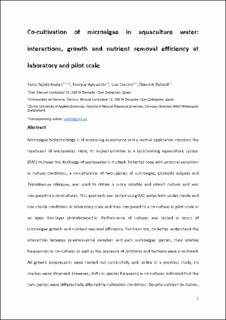Please use this identifier to cite or link to this item:
https://doi.org/10.21256/zhaw-20075Full metadata record
| DC Field | Value | Language |
|---|---|---|
| dc.contributor.author | Tejido-Nuñez, Yaiza | - |
| dc.contributor.author | Aymerich, Enrique | - |
| dc.contributor.author | Sancho, Luis | - |
| dc.contributor.author | Refardt, Dominik | - |
| dc.date.accessioned | 2020-05-25T09:45:05Z | - |
| dc.date.available | 2020-05-25T09:45:05Z | - |
| dc.date.issued | 2020-08 | - |
| dc.identifier.issn | 2211-9264 | de_CH |
| dc.identifier.uri | https://digitalcollection.zhaw.ch/handle/11475/20075 | - |
| dc.description | - Successful co-cultivation of Chlorella vulgaris and Tetradesmus obliquus - Stable cultivation despite presence of protozoa - Shifts in species frequency in co-culture likely caused by protozoa - Pilot-scale cultivation reached a final dry weight of 11.1 g l−1 - Maximum productivity at pilot-scale was 13.3 g m−2 d−1 | de_CH |
| dc.description.abstract | Microalgae biotechnology is of increasing importance and a central application concerns the treatment of wastewater. Here, its implementation in a recirculating aquaculture system (RAS) to lower the discharge of wastewater is studied. To better cope with external variations in culture conditions, a co-cultivation of two species of microalgae, Chlorella vulgaris and Tetradesmus obliquus, was used to obtain a more reliable and robust culture and was compared to monocultures. This approach was tested using RAS water both under sterile and non-sterile conditions at laboratory scale and then compared to a co-culture at pilot-scale in an open thin-layer photobioreactor. Performance of cultures was tested in terms of microalgae growth and nutrient removal efficiency. Furthermore, to better understand the interaction between environmental variables and each microalgae species, their relative frequencies in co-cultures as well as the presence of protozoa and bacteria were monitored. All growth experiments were carried out successfully and, unlike in a previous study, no crashes were observed. However, shifts in species frequency in co-cultures indicated that the two species were differentially affected by cultivation conditions. Despite nutrient limitation, the pilot-scale cultivation had a high productivity (13.3 g m−2 d−1) and final dry weight (11.1 g l−1) after 29 days and demonstrated its suitability for RAS water treatment. | de_CH |
| dc.language.iso | en | de_CH |
| dc.publisher | Elsevier | de_CH |
| dc.relation.ispartof | Algal Research | de_CH |
| dc.rights | http://creativecommons.org/licenses/by-nc-nd/4.0/ | de_CH |
| dc.subject | Aquaculture | de_CH |
| dc.subject | Nutrients | de_CH |
| dc.subject | Protozoa | de_CH |
| dc.subject | Water treatment | de_CH |
| dc.subject | Chlorella vulgaris | de_CH |
| dc.subject | Tetradesmus obliquus | de_CH |
| dc.subject.ddc | 570: Biologie | de_CH |
| dc.subject.ddc | 630: Landwirtschaft | de_CH |
| dc.title | Co-cultivation of microalgae in aquaculture water : interactions, growth and nutrient removal efficiency at laboratory- and pilot-scale | de_CH |
| dc.type | Beitrag in wissenschaftlicher Zeitschrift | de_CH |
| dcterms.type | Text | de_CH |
| zhaw.departement | Life Sciences und Facility Management | de_CH |
| zhaw.organisationalunit | Institut für Umwelt und Natürliche Ressourcen (IUNR) | de_CH |
| dc.identifier.doi | 10.1016/j.algal.2020.101940 | de_CH |
| dc.identifier.doi | 10.21256/zhaw-20075 | - |
| zhaw.funding.eu | Not specified | de_CH |
| zhaw.issue | 101940 | de_CH |
| zhaw.originated.zhaw | Yes | de_CH |
| zhaw.publication.status | acceptedVersion | de_CH |
| zhaw.volume | 49 | de_CH |
| zhaw.embargo.end | 2022-05-19 | de_CH |
| zhaw.publication.review | Peer review (Publikation) | de_CH |
| zhaw.webfeed | Aquakultur-Systeme | de_CH |
| zhaw.funding.zhaw | Biogas2Algae | de_CH |
| zhaw.author.additional | No | de_CH |
| zhaw.display.portrait | Yes | de_CH |
| Appears in collections: | Publikationen Life Sciences und Facility Management | |
Files in This Item:
| File | Description | Size | Format | |
|---|---|---|---|---|
| 2020_Tejido-Nunez-etal_Co-cultivation-of-microalgae.pdf | Accepted Version | 673.4 kB | Adobe PDF |  View/Open |
Show simple item record
Tejido-Nuñez, Y., Aymerich, E., Sancho, L., & Refardt, D. (2020). Co-cultivation of microalgae in aquaculture water : interactions, growth and nutrient removal efficiency at laboratory- and pilot-scale. Algal Research, 49(101940). https://doi.org/10.1016/j.algal.2020.101940
Tejido-Nuñez, Y. et al. (2020) ‘Co-cultivation of microalgae in aquaculture water : interactions, growth and nutrient removal efficiency at laboratory- and pilot-scale’, Algal Research, 49(101940). Available at: https://doi.org/10.1016/j.algal.2020.101940.
Y. Tejido-Nuñez, E. Aymerich, L. Sancho, and D. Refardt, “Co-cultivation of microalgae in aquaculture water : interactions, growth and nutrient removal efficiency at laboratory- and pilot-scale,” Algal Research, vol. 49, no. 101940, Aug. 2020, doi: 10.1016/j.algal.2020.101940.
TEJIDO-NUÑEZ, Yaiza, Enrique AYMERICH, Luis SANCHO und Dominik REFARDT, 2020. Co-cultivation of microalgae in aquaculture water : interactions, growth and nutrient removal efficiency at laboratory- and pilot-scale. Algal Research. August 2020. Bd. 49, Nr. 101940. DOI 10.1016/j.algal.2020.101940
Tejido-Nuñez, Yaiza, Enrique Aymerich, Luis Sancho, and Dominik Refardt. 2020. “Co-Cultivation of Microalgae in Aquaculture Water : Interactions, Growth and Nutrient Removal Efficiency at Laboratory- and Pilot-Scale.” Algal Research 49 (101940). https://doi.org/10.1016/j.algal.2020.101940.
Tejido-Nuñez, Yaiza, et al. “Co-Cultivation of Microalgae in Aquaculture Water : Interactions, Growth and Nutrient Removal Efficiency at Laboratory- and Pilot-Scale.” Algal Research, vol. 49, no. 101940, Aug. 2020, https://doi.org/10.1016/j.algal.2020.101940.
Items in DSpace are protected by copyright, with all rights reserved, unless otherwise indicated.